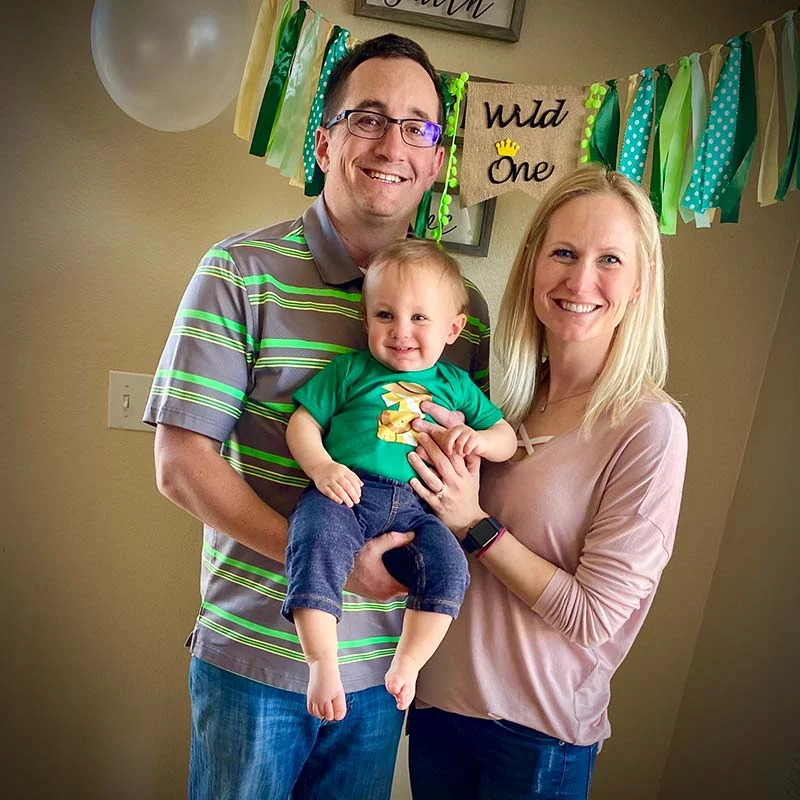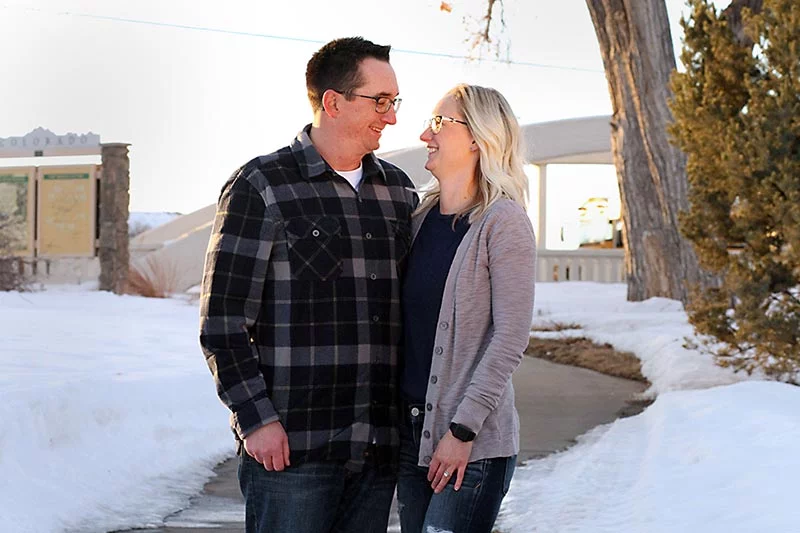
No matter how hard he tried, Cameron Armagost could not rid himself of the pain in his feet and legs.
“I thought I had bad boots,” he said. “I even told my wife (Jen) I needed new ones.”
The next day, he tried to celebrate Jen’s birthday in their hometown of Fort Morgan, but the pain was unrelenting and unbearable. He went to bed hoping it was just a pinched nerve that would work itself out, but the following morning, he began to panic.
“I couldn’t feel my feet,” said Armagost, market president at Bank of Colorado in Fort Morgan. “It was hard to talk. My speech was slurred. I couldn’t feel my hands and thought, ‘Did I have a stroke?’”

Armagost, then 35, headed to the closet to get dressed, but he lost his balance and fell to the floor. Jen, who was in the kitchen with their 1-year-old son, came running. She called their neighbor, a family doctor and close friend, who rushed over and did a quick assessment on that morning back in April 2021.
“All I can remember is the look on his face when he said he’d take my son and we needed to see a doctor, now,” Cameron recalled.
Their neighbor told them: “Don’t stop in Fort Morgan. Go to Greeley or Denver now.”
“I don’t remember much of that morning, but that replays in my head,” Cameron said.
Jen loaded her husband in the car, and they drove an hour to UCHealth Greeley Hospital. As he lay in a hospital bed, doctors in the emergency room told him they suspected he had Guillain-Barre syndrome (GBS). Cameron had never heard of such a thing.
GBS is a century-old mysterious disorder that often follows on the heels of a bacterial or viral infection. This rare neurological disorder wreaks havoc on the nerves as the body’s immune system which is supposed to attack germs that get into the body. In people afflicted with GBS, the immune system mistakenly attacks healthy nerves outside the brain and spinal cord. This damage prevents the nerves from functioning properly, which leads to weakness and, sometimes, paralysis.
When diagnosed early, GBS is treatable. Although weakness and nerve pain can be severe, many patients fully recover. Armagost’s case would prove more challenging, and it tested every ounce of his strength and sanity.

What is Guillain-Barre syndrome (GBS), and how is it diagnosed?
The first symptoms of Guillain-Barre syndrome are usually weakness and tingling in the extremities, but it can spread quickly, paralyzing the whole body. If it gets to the diaphragm, it can be deadly.

No one knows what causes GBS, though experts believe a problem in the immune system triggers it. GBS is not passed from one person to another, nor is it inherited.
Armagost told his doctors that a week before his hospitalization, he had a minor sinus infection while on a company retreat in Arizona and a sore throat after his return flight. He didn’t think anything of it.
Having a health history from patients helps physicians with their clinical diagnosis, said Dr. Brian Kaiser, a hospitalist who treated Armagost at UCHealth Greeley Hospital.
Research shows a connection between viral and bacterial infections and the onset of Guillain-Barre syndrome. In two-thirds of GBS cases, a patient had an infection, such as food poisoning, flu, or COVID-19, a few days or weeks before their diagnosis.
“Though we see Guillain-Barre with COVID, any viral illness could cause it, and only about half the time can we identify that trigger in patients,” Kaiser said. “That story helps support our clinical diagnosis, but by and large, we don’t care how it (GBS) started because the treatment remains the same independent the initial cause.”
A diagnosis of Guillain-Barre syndrome
Kaiser and his team of neuro-hospitalists treat about one case of GBS per month. When ER doctors suspected (and then confirmed) GBS with Armagost, Kaiser advised the team to immediately start IV immunoglobulin infusions (IVIg), a treatment derived from plasma donated by thousands of whole blood donors.
Immunoglobulins are proteins made naturally by the immune system to attack infecting organisms. IVIg is one of the primary treatments for GBS, and after a five-day course of treatment, patients are often discharged from the hospital to an acute rehab facility.
The treatment lessens the immune attack on the nervous system. But the damage to Armagost’s nerves was causing him horrendous pain. Doctors put him on pain medications, which added to the complications. Though 60% of patients fully recover from GBS, 15% continue to have severe and debilitating symptoms.
Sadly, it was not looking good for Armagost.

When GBS doesn’t respond to treatment
By Armagost’s fourth day in the hospital, it was evident that treatments were not helping him enough. The syndrome was progressing, and doctors had to put Armagost on a ventilator.
“At this point, he was not getting better. He looked worse,” Kaiser said. “This was one of the worst cases I’ve seen. Most people retain some movement of their arms and legs, but Cameron couldn’t move his legs or arms, and even his eye movements weren’t aligned with one another.”

Armagost’s condition started to become “touch and go.”
“It went from an autoimmune response to becoming the most progressed it could,” Armagost said. “I couldn’t open or shut my eyes. I couldn’t talk. For the next six weeks, I was only able to communicate with a slight nod to yes or no questions.”
Almost two years later, Armagost still gets emotional when recalling his condition.
“I could only hear and shake my head, and I was in a lot of pain,” he said. “I like to talk and not being able to do so made the whole process worse.”
Armagost remained on a ventilator for almost two months — three weeks in the ICU at UCHealth Greeley Hospital, three-and-a-half weeks at a long-term acute rehab facility and his first two weeks at Craig Hospital in Denver.
The mental struggle was a battle of its own.
“Mentally, when you lose most of your senses, your mind takes you to weird places,” he said. “There were a lot of mind games going on.”
His wife, Jen, whom he met on the opening day of the 2015 Colorado Rockies season, was his comfort. They married in 2018, and in March 2020, a few days before the pandemic shut down the country, they had their first son.
In the hospital, Jen had a gift for understanding what her husband needed when he couldn’t communicate it himself.
“She could read my mind and ask the right questions to find out my needs,” Armagost said. “Imagine being in a lot of pain, but you don’t know where the pain is. You think it is in your left foot, but it is in your right hand.”

He relied on his nurses to help him improve.
“I know it had to be difficult,” he said, recalling how the staff took care of him during those weeks. “It took a lot of people and a lot of patience to find the area causing the pain but moving my limbs gave me some relief.
“They didn’t just sit there and watch a machine breathe for me. Everyone was very involved.”
The clinical staff had to frequently clear Armagost’s airway. They moved his limbs for him, to help with pain. They helped him open and shut his eyes, applying ointment to keep them healthy. They held up a screen, so he could see his son.
During Armagost’s nonverbal outbursts, they calmly comforted him.
“I can’t express enough the respect I have for nurses,” he said. “I always knew their job to be hard, but you get someone like me who cannot speak. They have to read my mind and try to solve it as I get more and more frustrated. That takes a special person, an angel, who has a special place in heaven. It takes a special human with a heart bigger than anyone could ever imagine.”

Not sure if he will ever recover from Guillain-Barre syndrome
By June 2021, Kaiser transferred Armagost from Greeley Hospital to an acute care hospital about an hour from their home. There, he received rehab and began weaning off the ventilator. Three-and-a-half weeks later, he went to Craig Hospital in Denver.
Jen’s retired parents moved from Cincinnati, Ohio, to Fort Morgan to help with their son so Jen could be by her husband’s side as much as possible. At Craig, the road to recovery was still long. Armagost was taken off the ventilator within two weeks of arriving at Craig, but it was still unclear if he’d ever regain his mobility.
“At that point, I could kind of open and close my eyes,” he said.
“My family reminded me regularly if I ever said ‘I can’t do this,’ the response was always ‘not yet. But you will,’” Armagost said.
They were right. At Craig, with plenty of physical therapy, he began to slowly move his limbs, though everyday tasks like feeding himself were difficult. He questioned whether he’d fully recover.
“Of course, it crossed my mind many times that I wouldn’t be the same guy,” he said.
Doctors told him it may take upward of three years before he would walk — that’s if he ever did walk again.
But after months of grueling work, he managed on Sept. 13, 2021 – five months after GBS first attacked – to walk with crutches and braces on his legs into his office at the Bank of Colorado.

How long does it take to fully recover from GBS?
Nearly two years after GBS nearly destroyed him, Armagost said he is thankful for each day. He is happy to be a father, to be around to play with their son Colt, who is nearly 3, and Levi, his second son, who was born this past year.
But Armagost must remind himself to stay positive because he feels he is only 90% of fully-recovered.

“I don’t know if 90% is right, but I feel like I’m 90% of who I was before,” he said.
He still gets nerve pain “like someone is taking a blow torch to the bottom of my feet and putting needles through the bones in my hands.” He has weaned himself off most of the medications he had to take, except for the nerve blockers. He also struggles with fatigue.
“If I can get 14 hours out of a day, that’s pretty good,” he said.
Though he has difficulty walking uphill or on uneven surfaces, he managed to run the BOLDERBoulder 10K in 2022 — “something pretty momentous in my mission to overcome what GBS had taken away from me,” he said.
He hopes to return to elk hunting one day soon.
“Residual symptoms I experience on a daily basis are not debilitating,” Armagost said. “I have a good quality of life and am blessed to be where I am today. I have nothing to complain about, just things to work toward.”
He remains positive and hopeful that he’ll continue to improve.
“From where I was to here, I was lost and scared and hurt and had so much fear that I’d never be back to where I was,” he said. “I believe God blessed me to recover as much as I have, and I hope to be able to help others someday.
“I’ve learned there are no two things alike in injury and sickness, but with a positive attitude, faith and drive — having ‘grit’ — you can overcome anything. If you can get to that stage mentally, it’s amazing what you can accomplish.
“And I hope I can instill that in my boys, the power of positivity and faith … focusing on blessings in times of adversity.”

